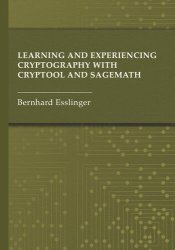Learning and Experiencing Cryptography with CrypTool and SageMath
- Добавил: literator
- Дата: 20-01-2024, 08:30
- Комментариев: 0
 Название: Learning and Experiencing Cryptography with CrypTool and SageMath
Название: Learning and Experiencing Cryptography with CrypTool and SageMathАвтор: Bernhard Esslinger
Издательство: Artech House
Год: 2024
Страниц: 665
Язык: английский
Формат: pdf (true)
Размер: 49.7 MB
This book provides a broad overview of cryptography and enables cryptography for trying out. It emphasizes the connections between theory and practice, focuses on RSA for introducing number theory and PKI, and links the theory to the most current recommendations from NIST and BSI. The book also enables readers to directly try out the results with existing tools available as open source. It is different from all existing books because it shows very concretely how to execute many procedures with different tools. The target group could be self-learners, pupils and students, but also developers and users in companies. All code written with these open-source tools is available. The appendix describes in detail how to use these tools. The main chapters are independent from one another. At the end of most chapters, you will find references and web links. The sections have been enriched with many footnotes. Within the footnotes you can see where the described functions can be called and tried within the different CrypTool versions, within SageMath or within OpenSSL.
This book is written for both laymen and beginners, as well as for students and practitioners who would like to delve deeper into this field. Anyone who enjoys prime numbers or wants to know what modern lattice methods are will find very understandable information here. For a large number of ciphers, you can find in tabular form what are currently the best attacks on them.
The first chapter of this book explains the principles of symmetric and asymmetric encryption and discusses definitions for their resistibility. Because of didactic reasons the second chapter gives an exhaustive overview of paper-and-pencil encryption methods and explains a typical example of a precomputer machine cipher that later became embroiled in scandal.
Chapter 3 gives a comprehensive overview about historical cryptology, a new research area, which deals with the practical problems of cryptanalyzing and
contextualizing encrypted historical documents.
A major part of this book is dedicated to the fascinating topic of prime numbers
(Chapter 4).
Then, Chapter 5 introduces modular arithmetic and elementary number theory using numerous examples. Here, the features of the RSA procedure are a key aspect.
Chapter 6 provides insights into the mathematical ideas and concepts behind modern asymmetric cryptography including a new geometric illustration of the processes involved in RSA encryption.
Chapter 7 gives a very brief overview about the status of attacks against modern hash algorithms and is then briefly devoted to digital signatures and public-key infrastructures, which are an essential component of e-business applications.
Chapter 8 describes elliptic curves, which are an alternative cryptosystem to RSA and are particularly well suited for use on smart cards.
Chapter 9 introduces modern symmetric cryptography. Boolean algebra is the foundation for most modern, symmetric encryption algorithms as these algorithms operate on bit streams and bit groups. Principal construction methods are described and implemented in SageMath. Compared to the other chapters in this book, this is the most mathematical one.
Chapter 10 introduces homomorphic crypto functions: Homomorphic encryption allows one to run calculations on encrypted data. This is a modern research topic that gets special attention in the course of cloud computing.
Chapter 11 gives a very easy lightweight introduction to lattices, an area that enables quantum-computer-resistant methods.
Chapter 12 describes results for solving discrete logarithms and factoring. This chapter provides a broad picture of the current best algorithms for (a) computing discrete logarithms in various groups, for (b) the status of the factorization problem, and for (c) elliptic curves. This survey was put together as a reaction to a provocative talk at the Black Hat conference 2013, which caused some uncertainty by incorrectly extrapolating progress at finite fields of small characteristics to the fields used in the real world.
Chapter 13 about the future of cryptography discusses threats for currently used cryptographic methods and introduces alternative research approaches (postquantum cryptography) to achieve long-term security of cryptographic schemes.
The individual main chapters have been written by various authors and are mostly self-contained. The main author contributed to all chapters and is responsible for any mistakes left. The contents covered are accompanied by numerous practical examples and SageMath code.
At the end of each chapter you will find references. The sections have been enriched with many footnotes. Within the footnotes you can see where the described functions can be called and tried within the different CrypTool versions, within SageMath, or within OpenSSL.
Whereas the CrypTool e-learning programs motivate and teach you how to use cryptography in practice, the book also provides a deeper understanding of the mathematical algorithms used, trying to do it in an instructive way.
Скачать Learning and Experiencing Cryptography with CrypTool and SageMath
Внимание
Уважаемый посетитель, Вы зашли на сайт как незарегистрированный пользователь.
Мы рекомендуем Вам зарегистрироваться либо войти на сайт под своим именем.
Уважаемый посетитель, Вы зашли на сайт как незарегистрированный пользователь.
Мы рекомендуем Вам зарегистрироваться либо войти на сайт под своим именем.
Информация
Посетители, находящиеся в группе Гости, не могут оставлять комментарии к данной публикации.
Посетители, находящиеся в группе Гости, не могут оставлять комментарии к данной публикации.
